Why Montpellier is France's most seductive and underrated city
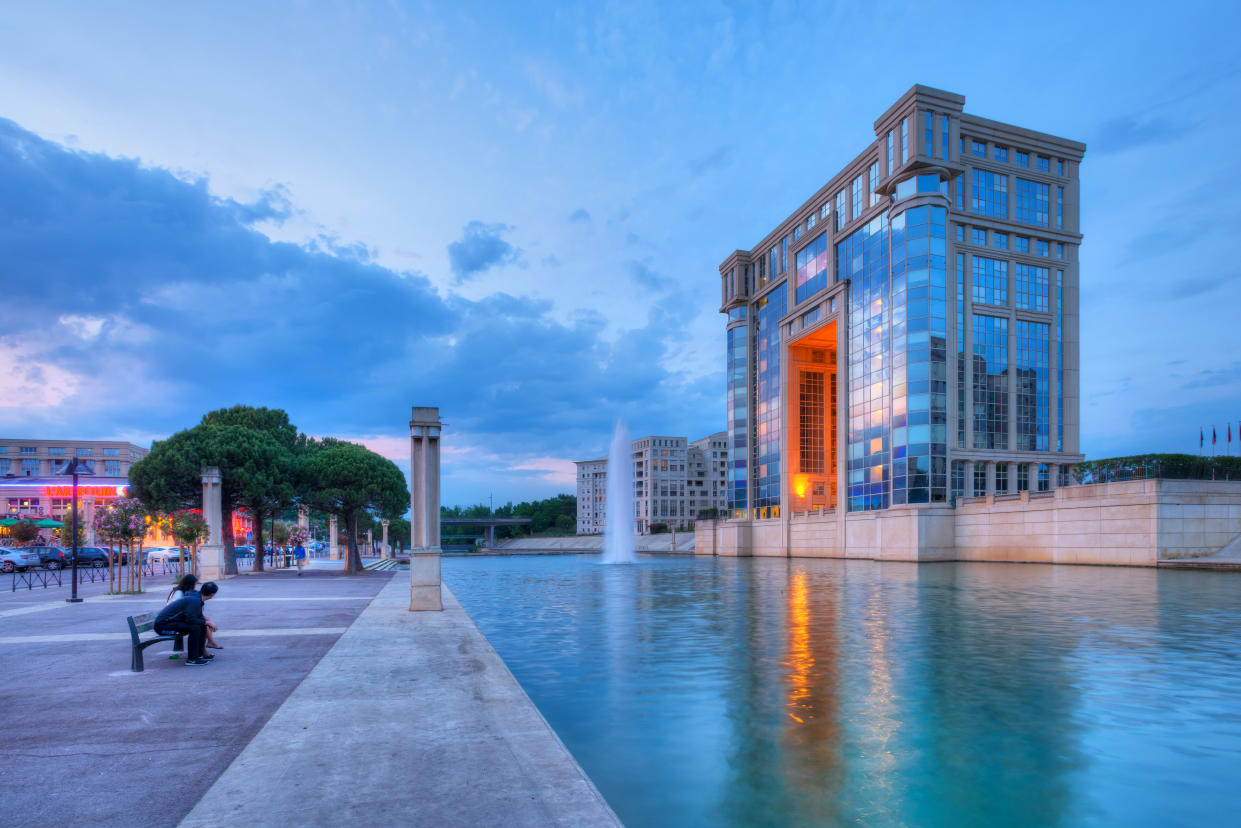
The Montpellier barman was really too busy to listen to me. (Him, and the rest of the world.) He was -being kept at a gallop by customers on his summer terrace in a small street crammed into the St Roch district.
“I used to live here,” I said. “Up above your bar.”
“Really?” he said.
“In the Seventies,” I said. But I was talking to myself. The barman had hurtled out with a tray-full of fruit juice. So I went out and looked up the side of the h?tel particulier – street-fronting town house – upon the roof of which I had lived.
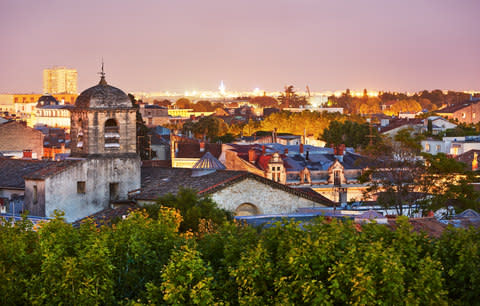
Montpellier, the capital of Languedoc, a few miles from the Mediterranean coast, was where I discovered France. We’ve been in a relationship ever since. We’ve perhaps matured -together – Montpellier into the most seductive provincial town in France, me into an older version of the seducer I never was. Back then, the city was emerging from a lethargic recent past of rentiers, wine decline and sun-lit slumber. I was fresh out of university, so given, too, to slumber and wine -decline. With a French future wife, I’d rented a wooden shack which grew, like a blister, from the roof in question.
You pushed the town house’s -monumental street door, entered the courtyard, climbed stairs through 18th-century marble splendour, -arrived at the third floor corridor, climbed a ladder to a hatch in the ceiling, squeezed through and there you were, in the cabin. These weren’t so much servants’ quarters as the quarters where the servants would stash their own servants. The blood froze in winter and boiled in summer. I couldn’t fit completely into the bathroom.
“Sorry, but I don’t remember you, Monsieur,” said the barman, returning at a sprint. “You wouldn’t; you’re only 13,” I said. He grinned, and I left.
Long ago, we were all jammed in these tiny, high-sided streets drawn tight around St Roch church in the heart of Montpellier’s -historic bit: the baker and the butcher and the grocer in black since her husband had been killed in Algeria. Workers and bourgeois lived cheek-by-jowl. Everyone in the few cafés knew everyone else and no one had heard of cocktails. Everyone on the streets was going somewhere specific – work, shopping, school, university. A knife-grinder on a bike rode through once a week (“Bring out your blades!”) Purposeless tourists were a surprise.
Elegant, subversive and sensual, Montpellier has become the most cultured and tolerant city in France
No longer. Fuelled by hi-tech industries, brains and brilliance, the city has spent 45 years or more growing faster than anywhere else in France – from 14th to eighth position, population-wise – while keeping hold of the Med essentials. Elegant, subversive and sensual, it has become the most cultured and tolerant city in France. Ambling visitors abound, thank heavens.
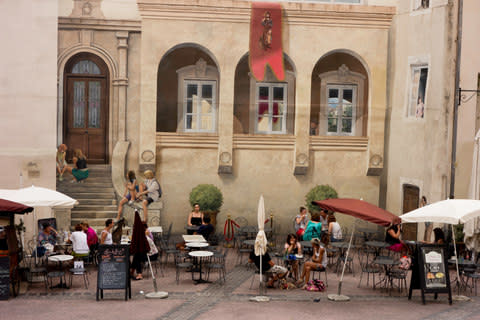
I’d kept in close touch over the years, but rarely returned as a (very) simple tourist. So that’s what I did earlier this month, in temperatures to fry the fur off cats. In my old St Roch district, what had been dark and functional had gone light and lively. Things which -people needed – bakers, butchers, cobblers – had ceded to things which no one needed but everybody liked: wine bars, bespoke chocolate shops, vintage frock shops, hole-in-the-wall T-shirt, jewellery and bagel outlets. Café terraces spread across the narrow streets now cars had been evicted. There was a sunshine ferment of leisure and lounging with labour, once to the fore, now lost down in the mix. The Beehive English pub and a salon de thé jostled with a tapas bar, a mojito bar, more restaurants than anyone could count, a café-boutique or two, a café-bébé with everything adapted for nippers and, facing the church itself, a building-sized trompe-l’oeil mural which few would have thought necessary four decades before. It worked brilliantly.
I meandered the labyrinth, then burst out on to the Place de la Comédie. The vast, sun-roasted square is where the medieval layout loosens its grip and the city sighs with relief. Trimmed with Haussmannian buildings apparently despatched direct from Paris, it’s been Montpellier’s focal point for -generations. In the 1970s, it was overcome with traffic. That’s all gone. These days, it is the grandest pedestrian square in Europe, disturbed only by the swish of trams way too graceful to be public transport.
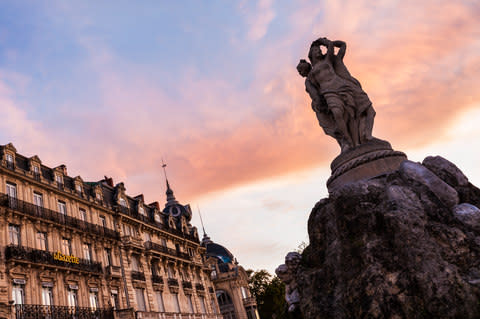
I took a table at Les Trois Graces, as usual, because (a) the café overlooks the Three Graces statue and (b) the young waiters there seem more focused than servers in other bars, so less likely to give the impression they were fitting you in between peacekeeping missions. Thus did I appreciate the stately spectacle of city life flowing past, the street performers and numberless students, impossibly handsome women with a metropolitan click to their heels and rooted bourgeois relics from a more discreet age, men arm-in-arm (Montpellier hosted France’s first gay wedding) and children playing… an entire swell of Latin life with no time at all and all the time they needed, the Mediterranean swagger underlit by irony and intelligence. Frankly, squares don’t get much better. As I moved on, a tidily-dressed lady in her middle years approached and asked for money that she might buy herself an iced coffee. This was begging, Montpellier style. I gave her the cash, and would have given her more, had she said she also needed a macaroon.
The Esplanade prolongs the Comédie square in park form. I walked thither, to the Fabre fine arts museum. Montpellier is cultured to the hilt, with festivals of theatre, music and dance, an orchestra, ballet company and two opera houses. High culture is a key constituent of an intellectual self-image untroubled by false -modesty. The Fabre is, until November 5, hosting a headline -exhibition bringing Francis Bacon and US multimedia artist Bruce Nauman face-to-face. Duty required attendance, but I knew the show would drive me crackers once I’d read that Nauman’s “panoptic systems… express the nonsense and alienation of the human condition”. Hell’s bells. Bacon’s tortured portraits and Nauman’s works – including a video of a bloke bouncing endlessly off a wall – may have been talking to each other, but they said nothing to me.

I moved on convinced, as usual, that I didn’t want art to tell me about bad things. I knew enough about them -already. I wanted beauty. I found much in the Fabre, notably among the 19th-century works. Best in show was the 1868 La vue de village – a demurely pretty girl fronting a landscape and village by Montpellier’s own Impressionist, Frédéric Bazille. Then I left, to plunge back into the city’s scurrying and scurrilous old centre, along sinuous streets barely wide enough for two fat tourists, past in-town mansions – peek inside; see the courtyards and ceremonial staircases – and ethnic -jewellers, coffee shops, unexpected squares full of bars and tables. It felt sunnily subversive. Shortly, I was at the cathedral and -attendant faculty of medicine, which together once constituted a huge monastery. Heavy and buttressed, the cathedral still looked ready to repel the ungodly, while the faculty spoke of a time when education wore gowns.
A tidily-dressed lady asked for money that she might buy an iced coffee. Begging, Montpellier style
Unlike its neighbours N?mes, Narbonne and Agde, Montpellier has no Greco-Roman past. It appeared only in the Middle Ages, owing its notoriety to medical skills born of Arab and Jewish influence. Medical excellence has since been a constant. Founded in the 13th century, the medical school is the oldest still operational in the world. As I visited, it was moving out of these classical buildings. However, the Museum of Anatomy – once a teaching tool – remained. You may visit only on a tourist office guided tour. Do so if you ever thought that syphilis was a laughing matter – as models make clear, it could eat your face away and replace it with froth – or have never before seen a conjoined twin foetus preserved in formaldehyde. Francis Bacon, it was clear, had ground to make up on reality.
I walked across to the associated -Botanical Gardens to clear my head. These, the oldest in France, are extensive and lovely, starring a 400-year-old mock privet tree, in whose trunk -indentations strollers traditionally -insert notes bearing “their most secret desires”. I pulled a fistful out. The first wanted “a well-paid job in Lille”, the second an end to his or her constipation, and the third “a pretty pony, when I’m bigger”. I added one of my own, -requesting promotion for Preston North End in 2018. So that was that sorted.
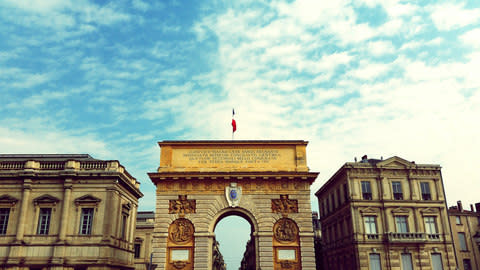
Up the road, the Peyrou Royal Promenade encapsulated past elegance, focusing on an equestrian statue of Louis XIV. It was erected when the city returned to -monarch and Catholicism after a bloody flirtation with Protestantism. The nearby Arc de Triomphe also flattered the Sun King. It led to a monumental avenue of posh shops upon whose awnings I would, in the 1970s, frequently crack my head. At over six feet, I was noticeably taller than the locals for whose height the awnings had been tailored. Now they’ve caught up, the awnings have been raised and so blood no longer dripped on to my shirt as I ambled. Towards the end of the street, opposite the Préfecture, were the first-floor premises of the language school where I’d taught English, using Playboy as a text book. Surprisingly, this had fostered swift academic -progress in both sexes.
Over following days, I pedalled 45 minutes out of town along the cycle track – past a wild and open land of scrub, high skies, lagoons and flamingoes – to the beach and sea-sidery of Palavas; I rolled round the extraordinary Antigone district which extends the city centre to the River Lez in -monumental bounds of neoclassical imagination unseen since the Med ruled the world.
Top 5 | French cities you'd never thought to visit (but really should)
I trammed out to the new Odysseum quartier, a play and shopping centre and the only place in the world where statues of Lenin and Mao (looking thin, I thought) stand within hailing distance of an IKEA store. I ate and drank as if in the shadow of -famine – -including at La Tomate (Rue Four des Flammes), one of few fellow survivors, and barely changed, from the -Seventies. It remained astonishing value for money.
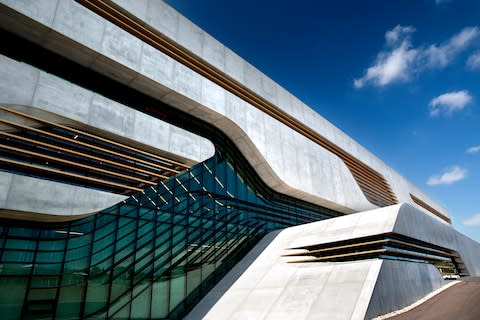
Then I went around the corner, back to the St Roch district, where the buzz of conviviality spilled from bar to terrace to enliven the warm night air. Every-one was out. I could think of -nowhere I’d rather be. I bobbed into the bar I’d been in before, another -Seventies survivor. “I remember you,” said the barman. “You’re the fellow I didn’t remember the other day.” He hurtled past, with a tray of pastis and beer and, for a moment, I was 23 again.
Getting there
Ryanair (ryanair.com) flies from Leeds, easyJet from Gatwick and Luton, BA (ba.com) from Heathrow. Or, for travel by Eurostar and TGV, Voyages SNCF (voyages-sncf.com)